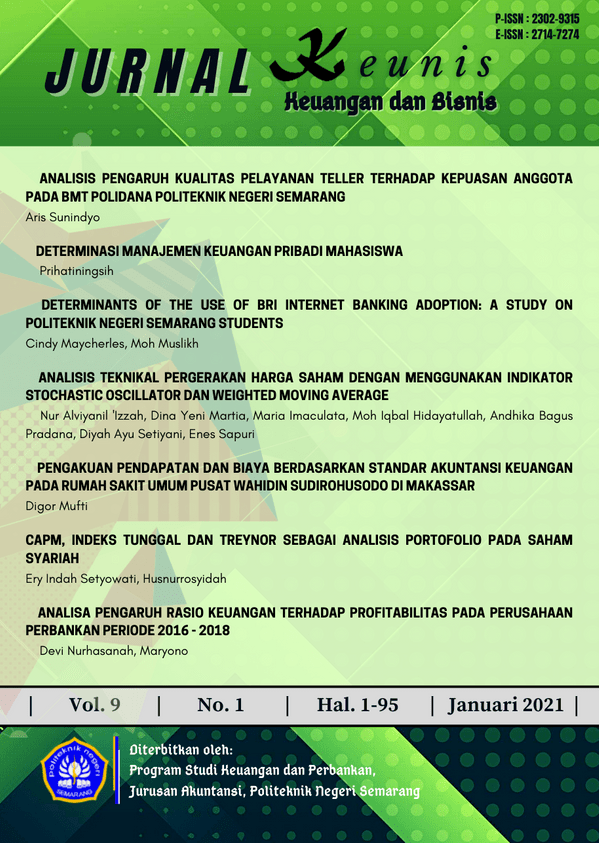CAPM, INDEKS TUNGGAL DAN TREYNOR SEBAGAI ANALISIS PORTOFOLIO PADA SAHAM SYARIAH
DOI:
https://doi.org/10.32497/keunis.v9i1.2222Keywords:
optimal portfolio, single index model, portfolio return, portfolio risk, treynor index, Capital Asset Pricing Model (CAPM)Abstract
This study aims to analyze the optimal portfolio of stocks using a single index model and the Capital Asset Pricing Model (CAPM) in making investment decisions as well as the expected profit and risk of the optimal portfolio formed on Islamic stocks in the Indonesian Sharia Stock Index (ISSI) on the Indonesia Stock Exchange. 2016-2020 period. This research design is descriptive quantitative research. The study population was all stocks that were consistently included in the Indonesian Sharia Stock Index (ISSI), amounting to 207 stocks. The number of samples of this study was 136 stocks using the Slovin method. The results show that there are 54 stocks that meet the criteria for optimal portfolio formation. The optimal portfolio of ISSI index stocks has a portfolio return rate of 21.95% and a portfolio risk of 10.49%. The portfolio performance based on the Treynor index shows that the best of the 54 stocks is PTSP shares amounting to 32.73% of the trading sector. While the results in determining investment decisions using the Capital Asset Pricing Model (CAPM) method and 136 company shares, there are 65 undervalued stocks, and 71 stocks are overvalued.
References
Darmawan, I. P. P., dan Purnawati, N. K. (2015). Pembentukan Portofolio Optimal Pada Saham-Saham Di Indeks LQ 45 Dengan Menggunakan Model Indeks Tunggal. E-Jurnal Manajemen Universitas Udayana, 4(12), 4335-4361.
Fahmi, I. (2018). Pengantar Teori Portofolio dan Analisis Investasi. Alfabet.
Hadi, N. (2015). Pasar Modal: Edisi 2. Graha Ilmu.
Halim, A. (2005). Analisis Investasi. Salemba Empat.
Hartono, J. (2017). Teori Portofolio dan Analisis Investasi: Edisi Kesebelas. BPFE Yogyakarta.
Hati, S. W., dan Harefa, W. S. (2019). Analisis Faktor-Faktor Yang Mempengaruhi Minat Berinvestasi Di Pasar Modal Bagi Generasi Milenial (Studi Pada Mahasiswi Jurusan Manajemen Bisnis Politeknik Negeri Batam). Journal of Business Administration, 3(2), 281”“295.
Husnan, S. (2003). Dasar-dasar Teori Portofolio dan Analisis Sekuritas. UPP AMP YKPN.
Kennedy, P. S. J., dan Yanis, A. (2019). Penentuan Keputusan Investasi Saham Berdasarkan Undervalued Atau Overvalued Price. Jurnal Akuntansi Dan Ekonomi FE. UN PGRI Kediri, 4(3), 1-9.
Lestari, F., dan Yunita, I. (2019). Analisis Investasi Portofolio Saham Optimal pada Sektor Perbankan Menggunakan Metode Model Indeks Tunggal dan Capital Asset Pricing Model (CAPM) (Studi pada Perusahaan Sub Sektor Bank yang Tercatat di Indeks LQ 45 Bursa Efek Indonesia Tahun 2012-2016). E-Proceeding of Management, 6(1), 115”“121.
OJK. (2012). Kriteria dan Penerbitan Daftar Efek Syariah. www.ojk.go.id.
Putra, M. D. M., dan Yadnya, P. (2016). Penerapan Metode Capital Asset Pricing Model Sebagai Pertimbangan Dalam Pengambilan Keputusan Investasi Saham. E-Jurnal Manajemen Unud, 5(12), 8079-8106.
Suroto. (2015). Analisis Portofolio Optimal Menurut Model Indeks Tunggal (Studi Empiris Pada Saham LQ 45 Di Bursa Efek Indonesia Periode Agustus 2012-Juli 2015). Media Ekonomi Dan Manajemen, 30(2), 161-177.
Suryani, dan Hendryadi. (2016). Metodologi Riset Kuantitatif : Teori dan Aplikasi Pada Penelitian Bidang Manajemen dan Ekonomi Islam. Prenadamedia Group.
Syulviya, S. A. (2015). Evaluasi Kinerja Investasi Portofolio Dengan Menggunakan Model Treynor (Studi Pada Perusahaan Food dan Beverages Yang Listing Di BEI Periode 2013). Jurnal Administrasi Bisnis S1 Universitas Brawijaya, 23(1), 1-10.
Tandelilin, E. (2001). Analisis Investasi dan Manajemen Portofolio (Edisi Pertama). BPFE Yogyakarta.
Tandelilin, E. (2010). Portofolio Dan Analisis Investasi: Teori dan Aplikasi Edisi Pertama. Kanisius.
Umam, K., dan Sutanto, H. (2017). Manajemen Ivestasi. Pustaka Setia.
Zubir, Z. (2013). Manajemen Portofolio: Penerapan Dalam Investasi Saham. Salemba Empat.
Downloads
Published
Issue
Section
License
KEUNIS is licensed under a Creative Commons Attribution-ShareAlike 4.0 International License.
Authors who publish with this journal agree to the following terms:
- Authors retain copyright and grant the journal right of first publication with the work simultaneously licensed under a Creative Commons Attribution-ShareAlike 4.0 International License that allows others to share the work with an acknowledgement of the work's authorship and initial publication in this journal.
- Authors are able to enter into separate, additional contractual arrangements for the non-exclusive distribution of the journal's published version of the work (e.g., post it to an institutional repository or publish it in a book), with an acknowledgement of its initial publication in this journal.
- Authors are permitted and encouraged to post their work online (e.g., in institutional repositories or on their website) prior to and during the submission process, as it can lead to productive exchanges, as well as earlier and greater citation of published work (See The Effect of Open Access).






